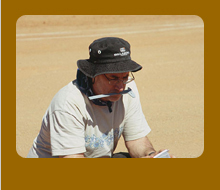
 |
|
Field ecology of Chersobius signatus Aim Determining baseline information on population size, population dynamics, morphology, growth, natural diet, tick infestations, and reproduction, for a single population in the northern part of the distribuiton range of C. signatus. Because the study was conducted over a period with wet and dry years, environmental effects were evaluated too. Materials and methods We used GPS, mark-recapture, radiotelemetry, thread-trailing, radiography, and ultrasonography. Timeframe and status The study started in 2000, and fieldwork was completed in 2004. The data processing and publishing took until 2007, and was completed with a Ph.D. dissertation in 2008.
Collaborators Although the work started as a short-time project, it was eventually incorporated in the Chelonian Biodiversity and Conservation programme of the University of the Western Cape (South Africa). Retha Hofmeyr and Brian Henen supervised the work, and were actively involved in fieldwork. In addition, the following field assistants participated: Patrik Abramsson, Mats Blohm, Tamara Harris-Smith, Chris Hobson, Janne Karlsson, Mark Klerks, Linn Lagerström, Tom Licitra, Frank van Loon, Peter van Putten, Jacobo Reyes, Ina Schettler, Fabian Schmidt, Sebastian Scholz, and Marsha van Tilborghs. The Dr. van Niekerk hospital in Springbok conducted the radiographic work. Finances Total budget was circa € 40,000. This amount includes resources that were invested by fieldwork volunteers and research materials that were donated, and does not contain salary: all Dwarf Tortoise Conservation participants work as volunteers and do not receive salary. Links Top |

